Self-Sufficiency Milestones & the “Magic Five-Year Threshold” | Rewilding Update
Feun Foo Permaculture & Rewilding Update (September 2024) - Part Two (Practice/Actions) --- [Estimated reading time: 30 min.]
This is the second part of the latest Rewilding Update, Part One can be found here.
In many of my most recent essays, I’ve struck a rather sour note, which might leave readers with the impression that I’m endlessly complaining about how terrible life is. I do indeed often tend to focus on the more negative aspects of the whole situation in my writing, perhaps a remnant of having grown up in Germany. We just love to complain. But, to be honest, this blog merely serves as an outlet for things that weight heavy on my mind. Life can still be beautiful, even as we’re living through the terminal phase of the dominant culture, and there are plenty of things that give me joy on a daily basis. But that doesn’t change the fact that witnessing the collapse of the world we grew up in hurts. It really fucking does.
I started this blog partially because I’ve found that writing helps me organize my thoughts, quiet my mind, and simply get things off my chest (which actually bother me considerably less after writing them down). In a way, as Jordan Lovinger from Years of Gap has commented on the first part, writing can be a form of therapy.
But let us not forget that there is no need to endlessly wallow in despair, at least not all the time: there are many reasons to remain optimistic, and many of them were beautifully summarized by my friend Shane from Zero Input Agriculture in one of his recent pieces.
I for one am a great proponent of the idea that things will ultimately turn out better than what we imagine, better than the worst-case scenarios that so easily grab our attention. Much of our everyday fatalism is caused by two things that, at this stage, most of us wrestle with in some form or another: depression and trauma.
In the climate fiction I write, people have found a way to survive “the Collapse” and adapt to the novel circumstances, and I don’t think that we’re necessarily heading for near-term extinction. The coming collapse marks the end of many things held dear by the dominant culture: megacities, mass society, industry, the internet, global supply chains, grain agriculture, and indeed civilization itself – but not “the end of the world.” It only appears as such for people who can’t imagine a life outside of civilization.
Moreover, Nature has an absolutely astonishing ability to heal herself if left alone, or, even better, if helped along by diligent rewilders. In any case, as Shane pointed out, resource constraints will put a real limit on how much damage can and will ultimately be done.
The first part of this Update focused on climatic changes and their detrimental effects on harvests & the environment, and yet the overall situation in Southeast Asia could be alleviated to a great extent if people simply did less of what they’re currently doing. The 2010 NIC report1 that I cite so relentlessly concluded that, until 2030, “Southeast Asia faces a greater threat from existing man-made environmental challenges than from climate change [emphasis added].”
This means that modern humans’ activity is even more dangerous than climate change. But it also contains a viable response: if people merely stopped destroying the environment any further, our collective chances of survival would increase considerably, even when factoring in climate change.
Everyone should be able to understand that healthy ecosystems are much more resilient than degraded ones.
And, indeed, a large part of the environmental impacts farmers are currently feeling (some of which I detailed in Part One) are at least partially self-inflicted,2 and could easily be mitigated by implementing basic conservationist & regenerative practices. What stands in the way is the brick wall of cognitive biases in people’s minds that keeps them from conceptualizing, understanding and responding to our predicament.
From the beginning on, our project has been centered around an awareness of the true severity of climate change. Most farmers were caught by surprise by the extreme weather this year – but not us. We’ve monitored climate data for years, read studies and reports, and we prepared for something like this since the very beginning, so the extreme weather was a sort of performance test for our slowly maturing Food Jungle.
And – all things considered – we’re not faring too terribly!
Self-sufficiency milestones reached!
For the months of April and May, well over 80 percent of our carbohydrate staple food came exclusively from Jackfruit & Cempedak seeds (henceforth shortened to “arto nuts,” from Artocarpus spp.), further cementing a dietary regime closer to nutritional self-sufficiency. We had volunteers and guests during this time as well, and eating rice for a change actually turned into a special occasion! Throughout June, the ratio was down to about 50 percent, but only because we gifted over a dozen Cempedak fruits to visiting friends and people in the village, and fed a bunch of partially damaged fruit straight to the chicken & rabbits (who love them!). In July, arto nuts were once again a smaller part of our daily diet, amounting to about 20 percent (but being substituted with cassava and boiled green bananas from plants that fell over in the heavy rain).
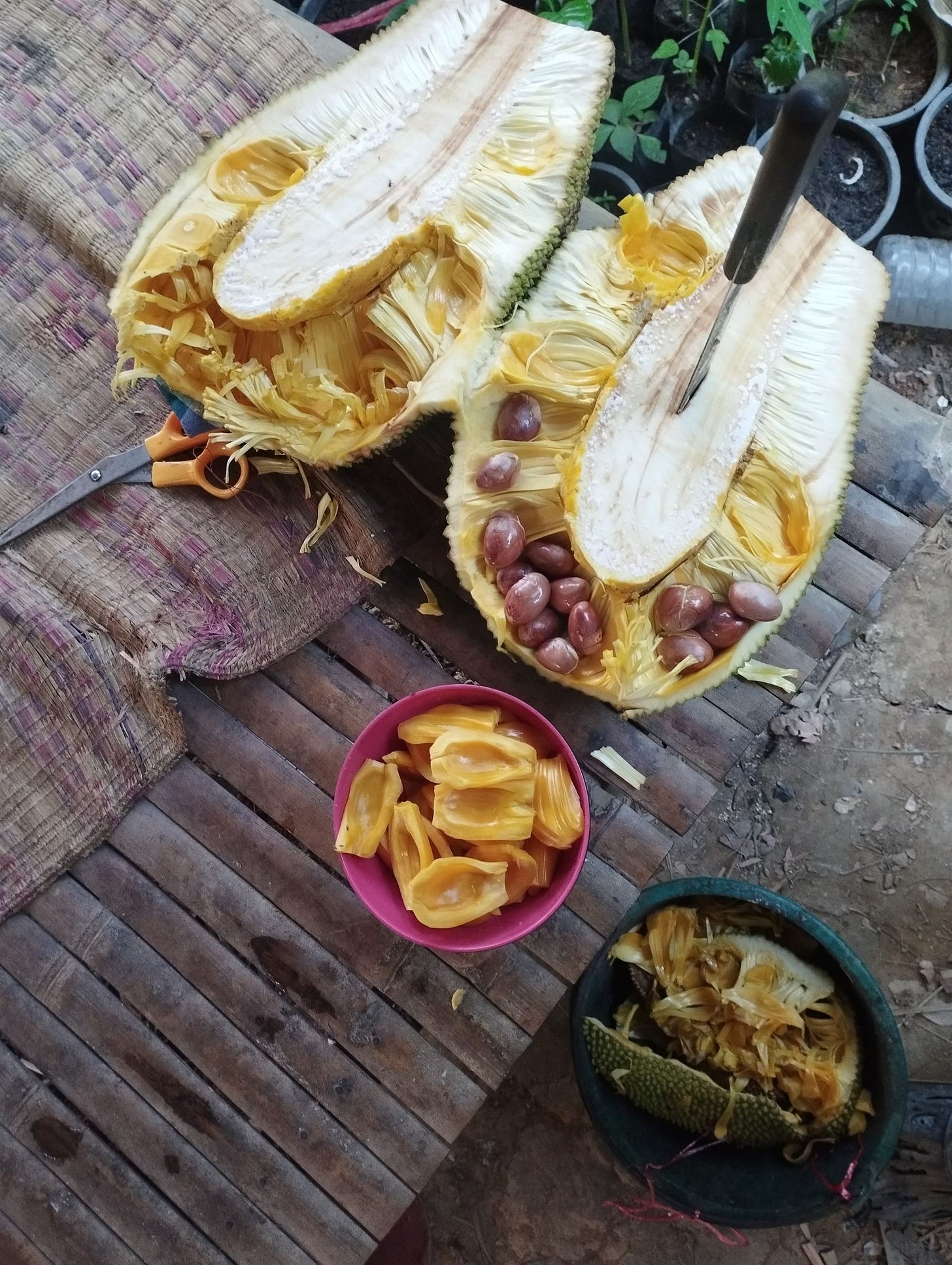
In a more serious situation it would have been easily possible to increase those percentages even more, for instance by not overeating (!!) and scheduling the boiling of seeds a bit better, or by taking the time to process fruit that got attacked by insects or squirrels. Sometimes we fed leftover arto nuts to the chickens, and some heavily damaged fruits (that nonetheless would have yielded a small bowl of nuts) were left on the tree for squirrels, birds and monkeys.
The cempedak tree behind the house produced a record-breaking sixty fruits, although most of them were much smaller than last year’s due to the lack of rain.3 Two other adolescent trees that just started fruiting recently produced a sizeable harvest, but the flesh was bland and unpalatable – for us, but not for the chickens & rabbits. We mostly didn’t care to process the seeds, because we weren’t hungry enough (and we still have plenty of rice left from last year that needs to be used up before this year’s harvest).
One “wet jackfruit” (ขนุนเปียก; a natural hybrid with cempedak that has much softer rind & flesh and is therefore much easier and faster to process) yielded an astonishing 275 nuts. Even from the smaller regular jackfruits, we got over a kilo of seeds each.
We’ve started seeding more “wet jackfruits,” for the exclusive purpose of utilizing the nuts. You can only eat limited quantities of the soft, soggy flesh, because it turns into a mushy lump in your mouth that is difficult to swallow due to the long fibers it contains.4 Often, we simply suck the honey-like juice off the arils, extract the seed and throw the rest into the chicken bucket.
Overall, it seems that arto nuts can easily become a reliable & resilient seasonal staple food in our climate, and even in bad years they can produce relatively abundantly. Once the trees we planted ourselves start fruiting (in 2-5 years), we will definitely be able to feed a few more hungry mouths.
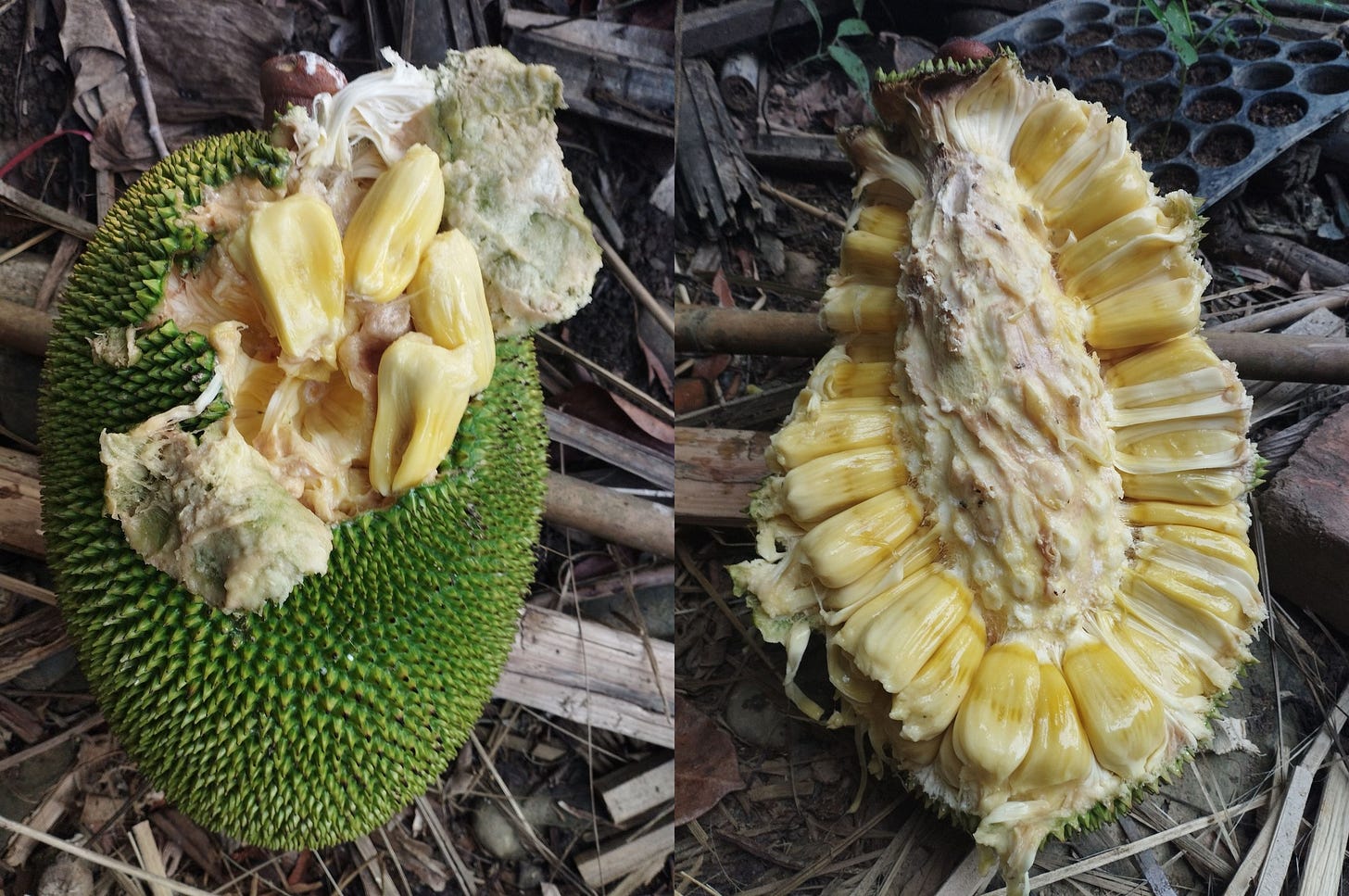
Much to Karn’s delight, this year was also the first year we had bamboo shoots throughout the entire dry season, as our pile of “bamboo that forgets the drought” (literal translation of the Thai name) kept on shooting and shooting even through the driest months. It is, admittedly, located right next to our pond, so it never lacked water. But what makes this species special is the ability to theoretically produce new shoots year-round, if external conditions are favorable.
With a mix of continuously thinning out older stems and heaping several dozen buckets of mud from the pond onto kin base, the abundance ki5 gifted us with meant we had bamboo shoots pretty much every week.
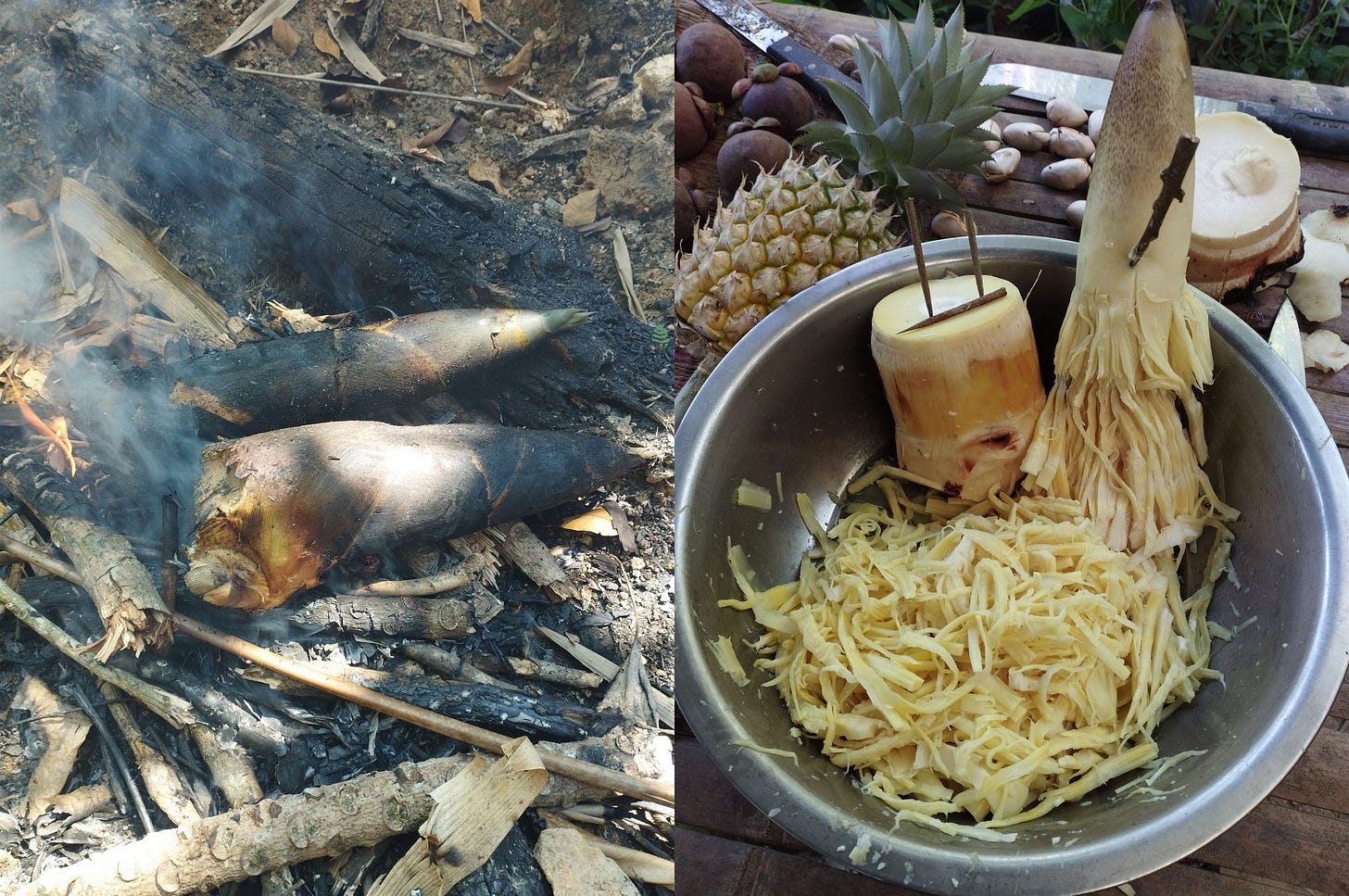
There were other, humbler “self-sufficiency milestones” as well: for the first time, both our black pepper and our coffee lasted for more than half the year. We harvested a decent number of limes, and were even able to incorporate the locally much-famed cardamom shoots into our meals on a regular basis. And in no previous year did we harvest this many mushrooms!
Since our land was never continuously inhabited before, in the beginning we lacked the most basic regular ingredients & herbs that many rural households have growing in their backyard kitchen gardens: chili, galangal, lemongrass, keffir lime, turmeric, fingerroot, ginger, black pepper, several species of basil, limes, and a few others. We’ve slowly started catching up over the years, so that all the aforementioned are available most of the time.
Because we can go to the market only once per week or so (depending on the weather, our mood, and of course how much food we have from our garden), in the beginning we simply omitted certain ingredients, and replaced others with substitutes. For instance, we didn’t have a single lime tree when we moved here, so we often used sour tamarind paste from Karn’s sister instead.
But fruit harvests this year were generally very low.
Mangosteen, our main “cash crop,” pretty much failed, meaning that we didn’t have any surplus to sell. Last year was already a bad year for mangosteen, but this year was abysmal. There was enough for us to eat and to share with friends & family, fortunately, but the overall harvest was a massive failure.
Compared to last year (when steady rains caused them to hesitate repeatedly), the trees started flowering very well – almost a bit too well – and developed an abundant first fruit set. But two months later, about half had fallen off already. This happened even in neighboring orchards where people irrigated as long as they had enough water.
Same goes for rambutan. Only two of our four mature trees fruited (both were the more hardy, semi-wild cultivar, not “Rongrian”), and the bulk of the rambutan crop was harvested by hungry monkeys. We didn’t mind, because the few large branches we cut in time were enough to satisfy our immediate cravings, and the monkeys forgot a few scattered fruits here and there, which we harvested during the annual pruning.
Additionally, we didn’t harvest a single avocado, and virtually no abiu and rollinia for the entire dry season.
But this year wasn’t only hard for humans, it was equally difficult for many other animals. We could both feel and see it. Squirrels and monkeys took a substantially larger share of fruit than usual, indicating a generally lower availability of foods in the forest and adjacent orchards. Besides most of the rambutan, they regularly harvested nine of our twenty-some mature mangosteen trees (all of those bordering the forest, and seven of them without leaving any for us).
And we let them enjoy their feast – they have it hard enough already right now.
But in the long term, we might have to think about ways to ensure that the monkeys don’t get too ambitious, since they’re slowly losing their fear of us after six years of friendly advances from our side (and curious stares from theirs).6
Our larger wild durian trees (age ten to twenty years) were surprisingly resilient and productive (20-30 fruits per tree7) despite not being irrigated at all – but the main commercial cultivar (“Monthong”) disappointed as well (a mere dozen fruits per mature tree). About five to ten percent of the wild durian was partly eaten by squirrels, which is something that we care less about since we eat the fruit the same day it drops from the tree, and usually all other arils are still perfectly edible.
Another “milestone” for us (if it even merits this name for anyone else) is that we eat more meat. Finally. Over the past few years, we still bought meat at the market about once per week, as a special occasion and a reward for our hard work. Good quality meat is extremely difficult to find (and super expensive), so compromises had to be made. But this year, especially in the second half, we feel like we haven’t really stopped eating animal protein from our own garden! Because there were so many squirrels we felt confident enough to hunt a greater number of them than in previous years, when we were still carefully assessing a sustainable harvest rate. We slaughtered our first rabbit recently and because the rabbits are such a promising source of meat, we have decided to reduce the number of chickens a bit, so we already ate several chickens as well this year. Besides that we finally got ourselves a decent fish trap (we simply didn’t have the time to make a good one from bamboo ourselves), so we regularly eat freshwater shrimps and smaller fish as well. And whereas in previous years we tried to increase the overall amount of chickens as fast as possible, we now appropriate about half of the eggs our hens are laying.
Again, this might not seem special for anyone else (especially folks who’ve been doing this for some time), but for us it really is. It took six years to get to this point.
Although the land was planted in a few mature fruit trees & giant bamboo when we moved here, in terms of soil quality (and thus the ability to grow vegetables), we basically started from zero.
A big disappointment was the complete failure of this year’s honey harvest. Only one of our three hives was more or less continuously inhabited, and another one was abandoned after our neighbor sprayed a new type of pesticide.8 Whereas last year we harvested more than four liters of wild honey, this year all we got to eat were two stingless bee hives in old bamboo segments. There’s still one bottle left from last year, which we save to use for medicinal purposes.
All quiet on the upper front
During much of the dry season, we did practically nothing in the upper part of the land. We decided it was best to leave the land undisturbed, after establishing an initial layer of mulch from tree pruning at the beginning of the year, when the soil was still wet. It soon became too dry to prune trees, and we thought it best to keep the entire area as shaded (and thus as cool) as possible.
The exceptional drought (and heat!) also meant that we harvested very little from the upper half, apart from a few wild berries here and there, and – of course – firewood.
But although harvests failed to materialize (apart from a pleasant surprise in form of a bunch of sweet Thong Ho bananas), our strategy worked: despite not watering any of the trees – not even even 1.5-year-old grafted durian trees! – not a single tree died in the entire area. This is already a huge success for us – harvests be damned, at least our trees survived!
Nonetheless, you could sense the stress, as a few usually evergreen trees went deciduous for a change, such as the 3-m-high local jungle fruit Schleichera oleosa (ตะคร้อ/บักค้อ) and one of our two-year-old Kratom trees, who lost all foliage early on (but has since recovered).
As seen in the two pictures above, we took out another one of the 5-year-old Acacia mangium, to mulch the chicken pen during dry season (which is a steady task since mulch disappears fast with the chicken constantly working through it.) We cut it at about 3m height (the first leaved branch), and it has since started resprouting.
Only towards the end of dry season did we start to expand the area with vegetable beds on the upper border of our land. Right next to the fire break (the border to the Nature Reserve) there is ample sunshine, so we use this “grey zone” to cultivate a few hardier vegetables & herbs. Piles of dry bamboo, placed on the areas that will be planted with annuals, were carefully burned in an effort to imitate traditional shifting cultivation (“slash-and-burn”) and utilize its many benefits for tropical horticulture. I would have loved to start a bit earlier, but Karn advised caution due to the extreme drought, and, as so often, she had a good point.
In this time (and climate!) it would be utterly irresponsible to take unnecessary risks.
The “Magic Five-Year Threshold”
I’ve had quite a few tropical permaculturalists tell me the same thing: “yes, the beginning of such a project is difficult (if you’re not rich and/or don’t start in ideal conditions, that is!), but after the first five years it gets easier.” I haven’t been able to find any real references for this anecdote, but after passing this threshold ourselves, I can’t help but think there’s something to it.
The first trees we’ve planted in the very beginning are starting to bear fruit, and by now we’ve had ample opportunities to plant & replant our own cuttings and seedlings. At this point, we’ve worked with the soil for over half a decade, carried mud, made compost, and chopped-and dropped literally tons of vegetation. At some point all that work must start paying off, and with a bit of a delay (we’re living in tree time, not human time), we can now feel & see it clearly – if not in immediate harvests, then at least in overall growth.
Now, in the sixth year, the place is slowly getting packed. There are not too many more main slots to be filled in the burgeoning food forest ecosystem, so we are more frequently taking out adolescent wild trees to create breaks in the emerging canopy, which we leave growing (for the most part) wherever they sprout vigorously and are not immediately in the way. This is done in order to create the ecological niche for certain, more sun-loving crops (like banana) or to plant other trees that feed on the decaying root system and mulch of the previous tree.
But overall, it feels like things are in place roughly as they will be for the coming years and (hopefully) decades.
There was finally a bit less planting work at the onset of rainy season, which is always a time of intense work. But instead of planting, we have been doing so much pruning and chop’n’drop! This is the first year in which we have enough cuttings to keep more or less the entire land mulched at all times, despite the chickens’ constant efforts to open up the soil. It feels like we’ve reached a “syntropic milestone” as well, and after roughly five years after we first moved here many of the forest trees growing wild were getting large enough to allow for near-constant pruning. It’s one of my favorite tasks, high up in the tree with the wind in my hair and my skin on the bark, carefully pruning branches with our handsaw and throwing them down to Karn, who is busy swinging the machete.
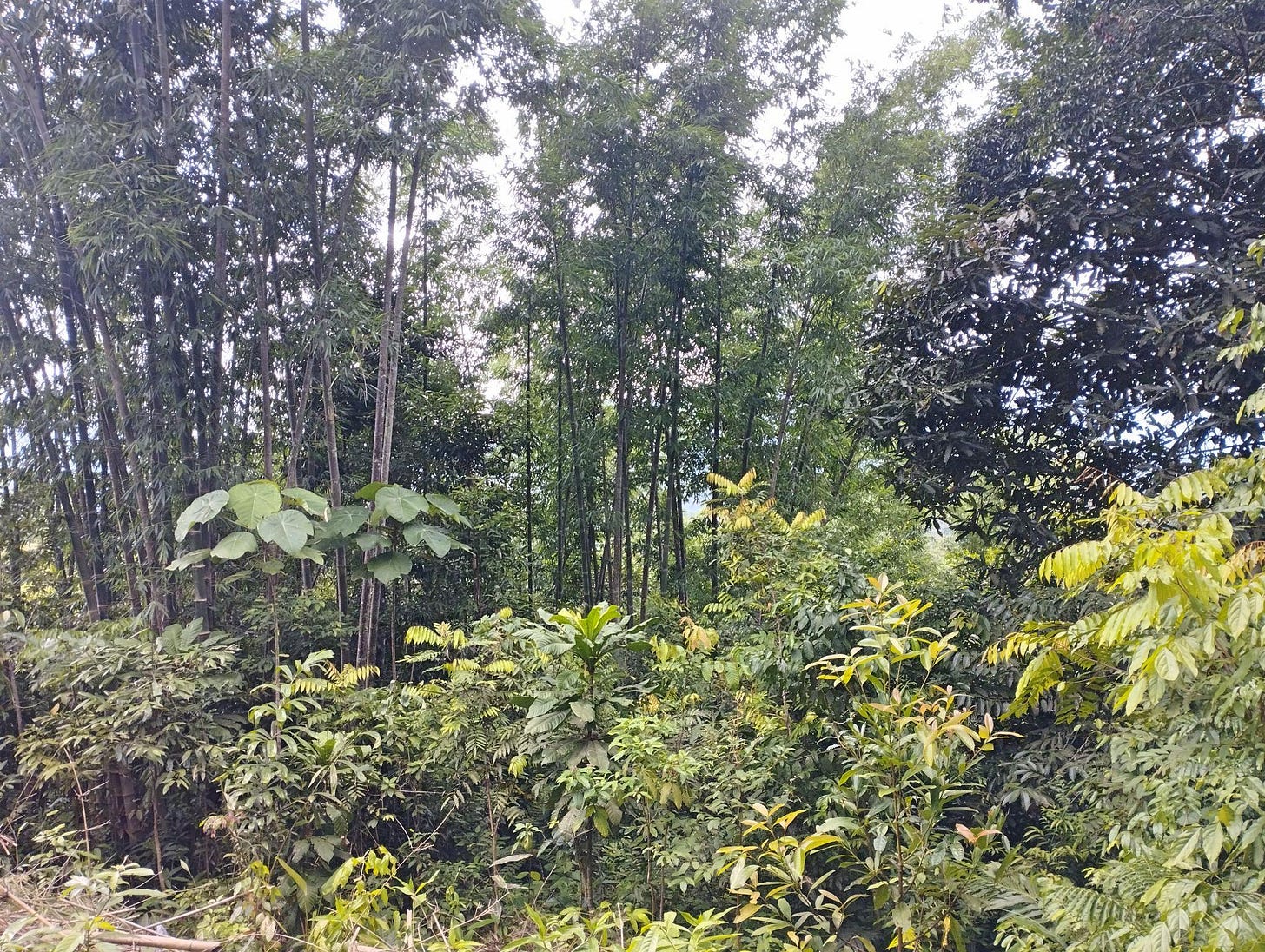
One aspect that definitely feels like we’ve crossed a threshold is in terms of the beauty, ambience, and general atmosphere of our emerging Food Jungle. It is getting really beautiful here, and although I know I say this every year, it does feel so much more like a forest! Even the areas that were completely open in the first few years are now starting to look more like something resembling a young forest. There is plenty of shade, almost everywhere.
Many things did indeed get easier once we passed the five-year threshold, also because we start to get a better feeling for the various seasonal tasks and their timing (which doesn’t mean we still lag behind occasionally).
Still, sometimes I feel a bit ashamed, lamenting that we still can’t grow papaya, or even regular eggplant, that there are still times when we don’t have any bananas, and at times I can’t help but feel regret for not having worked harder & done more. Maybe I just have to adjust my expectations, and let go of the last remnants of German work ethic that remain hidden deep within my subconscious.
But if you live a low-tech lifestyle, daily household chores alone take up a considerable chunk of your time. For about six years now, we have been doing all our laundry by hand, and it quickly adds up over time. Basically all our meals are prepared from scratch, so we spend several hours every day gathering & processing ingredients and preparing & cooking food.
Additionally, in the tropical heat you do need time to rest. Especially at the height of dry season, a two- to three-hour siesta is pretty much mandatory to avoid averse health effects. And we don’t have to be productive at all times; the key to happiness is to be content with what one has. This is, in my opinion, one of the most useful lessons that we can learn from our cats: a day spent resting is a day well spent – provided there’s somebody who cooks for you!
If it weren’t for the highly erratic weather, we would have likely experienced our first year of true abundance. It still felt abundant enough, though, and – like the Dust Bowl farmers (see Part One), perhaps in vain – we still have a bit of hope that the next year won’t be as bad.
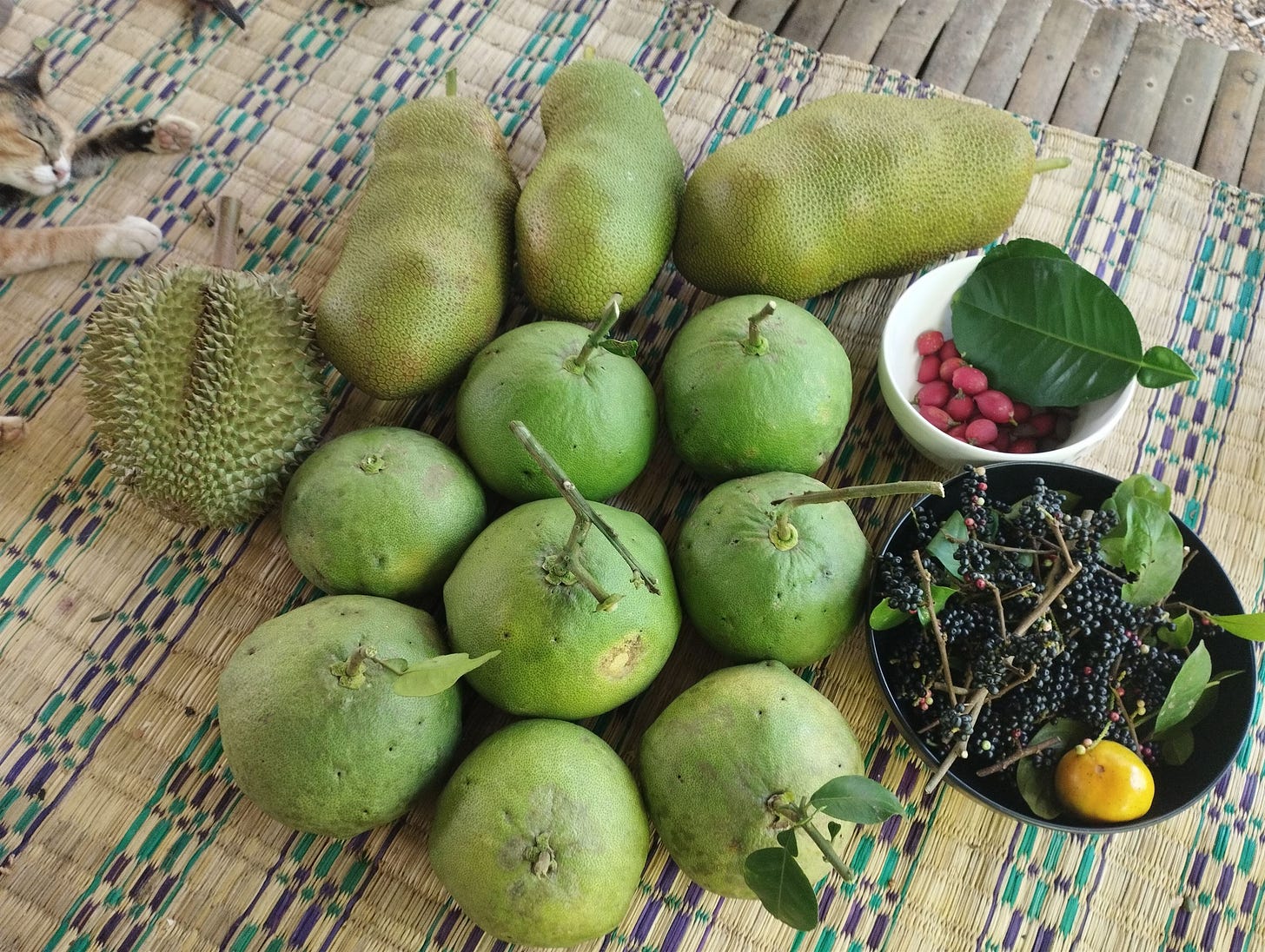
Although there’s still many crops we simply can’t grow (but would nonetheless like to have in the garden),9 we feel comfortable with the overall yield from our garden thus far, because even though it might not be enough to make a modest profit, at least our immediate biological needs are met.
Enough to eat, but not enough to sell.
Karn summed up the dilemma in this memorable little adage:
มีกินไม่มีขาย มีขายไม่มีกิน
(mee gin mâi mee kăai, mee kăai mâi mee gin)10
In Thai, relatively complex concepts can be conveyed through a cleverly combined string of short, simple words, as this example shows. The meaning roughly translates to “if you have enough for eating, you don’t have enough for selling, and if you have enough for selling, you won’t have enough to eat,” but the implied meaning is much deeper.
We are presented with two ways of farming for Thai smallholders: one with the goal of producing sellable goods to get money to buy food (the currently predominant way), and the other one to simply produce your food yourself (the traditional, virtually extinct subsistence-based approach). Compromises between the two are possible, but not always easy – especially for people without prior experience, and especially in the beginning. If you want to feed yourself (not just “grow some veggies”) in our bioregion, you need a hyperdiverse, labor-intensive agro-ecosystem (including at least one or two species of livestock) that has to be adapted to local conditions, requires no chemical inputs (or any other regular investments), and might not produce the exact set of crops we would encounter on the shelves of a supermarket. Such a system may produce many small, highly seasonal harvests of different crops (some of which might be unmarketable for various reasons) that might in addition be slightly damaged by insects and/or not as large and uniform as commercially grown produce – but otherwise perfectly good to eat.
It makes little sense to carry whatever meager surpluses you have on a daily basis to the market, just to fetch laughably low prices for them. Especially if you are, like us, far away from the closest market.
If, on the other hand, you plant a monoculture of any cash crop, (if the climate allows it) you will end up with “something to sell,” and (if the economy allows it) you will have enough money to buy all the food you want – but you won’t have time and space to be allocated towards growing your own food, and nor would you perceive a real need to do so. Why waste your time if you can just buy stuff at the market?
One of those ways is physically demanding, at times uncomfortable and carries a certain social stigma, but is much more resilient in terms of external shocks of any kind. If the economy collapses, at least you won’t starve. If extreme weather causes losses, you have other things to fall back on.
The other is less labor-intensive,11 but is detrimental towards personal & environmental health and only functions if the climate is reliable, the economy stable, chemical inputs and fuel affordable, and if demand for the end product is high.
Many years ago, the Thai Department of Agriculture made a short (grossly oversimplified and romanticized) ad in an attempt to convey something like this, albeit with negligible rates of success in the real world:
The main obstacle to “living the dream”
We personally know many people (fellow millennials, for the most part) that would love nothing more than to quit the busy city life and move back to the countryside, to live a quieter, simpler and more peaceful life. One might go as far as to call it the “New Thai Dream,” as even many rural-born GenX’ers (who spent most of their adult lives in the city, working factory jobs, as drivers, or in construction) often dream of saving enough money to live comfortably in their home village, plant a vegetable garden, keep a few chickens, cows, maybe a water buffalo… And while the coating of this Thai Dream is a rosy idealization of traditional rural life that has become all but unachievable in the 21st century, at the core there is a much more profound longing: an incessant pull back into Nature’s bosom, away from the overcrowded, noisy and polluted urban centers, and towards meaningful connection.
The single biggest obstacle for disillusioned young people looking for a fresh start is money, or better, the lack thereof. “I’d love nothing more than to move back home, but how am I gonna earn money?” is a concern we hear quite often.
And indeed, the first few years are the biggest challenge. Most agricultural land here in Thailand (and probably in most other tropical countries) is severely degraded, and is currently only productive due to ever-increasing chemical inputs. The transition to low- or no-input methods of cultivation takes about five years in this climate zone, which is both the time it took us to feel reasonably confident & comfortable on the land – and the time it took for Cuban agriculture to recover from the shock caused by the sudden cessation of fossil fuel & fertilizer imports from the Soviet Union after its collapse. (Now that I think about it, this is an excellent reference & example for the five-year threshold outlined above.)
Before that, feeding yourself (let alone making a sustained profit) can be pretty difficult. Hence, up until this “magic five-year threshold” (and maybe even beyond), some sort of supplementary income is needed.
We can’t go back to the land without financial support
If we were to finally kickstart some sort of much-needed back-to-the-land movement any time soon, an allowance (or a “UBI” of sorts) would be necessary as an incentive, especially for younger generations that haven’t been able to save up due to capitalism spiraling out of control. Our own experience has shown that the lower level of such a stipend would have to amount to 5,000฿ ($140) per month per household (without children!), with 10,000฿ ($280)/month being closer to a comfortable optimum for people with lower tolerance for discomfort.
Read more:
I am well aware that it would be hopelessly naive to seriously expect that such a scheme will be implemented in time. And yet, I somehow hope that at least in some places, on a grassroots level, people will come up with ways to help finance the transition to a saner way of living as long as that’s still possible. And since we can’t confidently rely on those with the most wealth to give up any of theirs – absent an actual revolution – a slightly more horizontal wealth dispersal would have to be aimed for.
The somewhat infamous “boomers” and the GenX’ers were the two generations that benefited most from the highest energy- and resource-per-capita levels in human history. They could, for the most part, realistically expect to live some version of the American Dream, afford a car and a private home, and raise a family. Most of them were even able to save up some of their earnings to cover the period when they were too old for working, as the traditional household/community that had previously taken care of the elderly had been dismembered in the process.
Things have changed for the younger generations, and we find ourselves confronted with a world characterized by scarcity and ruthless competition for increasingly limited jobs & resources. Things aren’t as easy anymore, and stuff has gotten a lot more expensive. The system has busily monetized every part of daily life, and society as a whole has become a whole lot more standardized, which makes thinking and going “against the tide” progressively precarious.
While it was perfectly possible to survive on odd side jobs, occasional gigs, freelance writing, handicrafts, art and other supplementary income just a few short decades ago, alternative lifestyles have been systematically exterminated by the dominant culture. And this trend has accelerated considerably in recent years. Cheap Chinese consumer goods are eliminating the need for local artisan- and craftsmanship, generative AI is decimating the demand for artists and designers, and LLMs are currently rendering many freelance writing jobs obsolete. More and more industry-friendly “food safety laws” turn localized small-scale food production into a minefield of regulations and prohibitively expensive requirements, and part-time or informal side jobs that pay enough to finance even a lifestyle of increased self-sufficiency are harder and harder to find. An increasingly deregulated and competitive market has exterminated many smaller producers and manufacturers, and left us helpless victims to corporate price hikes and an overall decrease in quality of goods & services.
At the same time, the things the system requires you to pay for regularly simply so you are able to continue being a member of society have become increasingly expensive. They include basic necessities & groceries, rent, various taxes, fees, insurances and subscriptions, but also the ever larger array of rapidly decaying consumer electronics that have, as Uncle Ted predicted, turned from an optionality into mandatory aspects of everyday life.
As a result, many alternative living arrangements & projects like ours have been gradually pushed back into bondage – or straight over the edge.12
And many more will follow. We pray that we won’t be among them, but if things don’t simplify soon, we might have no other chance.
We were extremely lucky to make it through the first five years, but others might not have our luck, privilege, endurance or tolerance for discomfort. Few people in the so-called “developing” world have lucrative side hustles, freelance jobs, or can make use of donations from richer countries, like I do with this blog.
Yet I firmly believe that a wider back-to-the-land movement would be one of the most worthwhile responses to the polycrisis. We would surely welcome the company, and we could really use some helping hands & minds!
Seasonal tasks
Another reason why it seems like we’ve passed a “magic threshold” is that, by now, we’ve roughly internalized the specific tasks that need to be done each season. Since the rains have started, we have been busy with our annual flood preparations, and this year we’re finally on time. Despite living on a hillside, the soil in our garden often becomes quite waterlogged due to near-constant rains. In a bid to relieve the issue, every rainy season we excavate little ditches on the uphill side of our vegetable beds. The soil is piled up on the beds, which are consequently mulched generously, both to protect the loose soil from the rain and to hide it from the chickens.
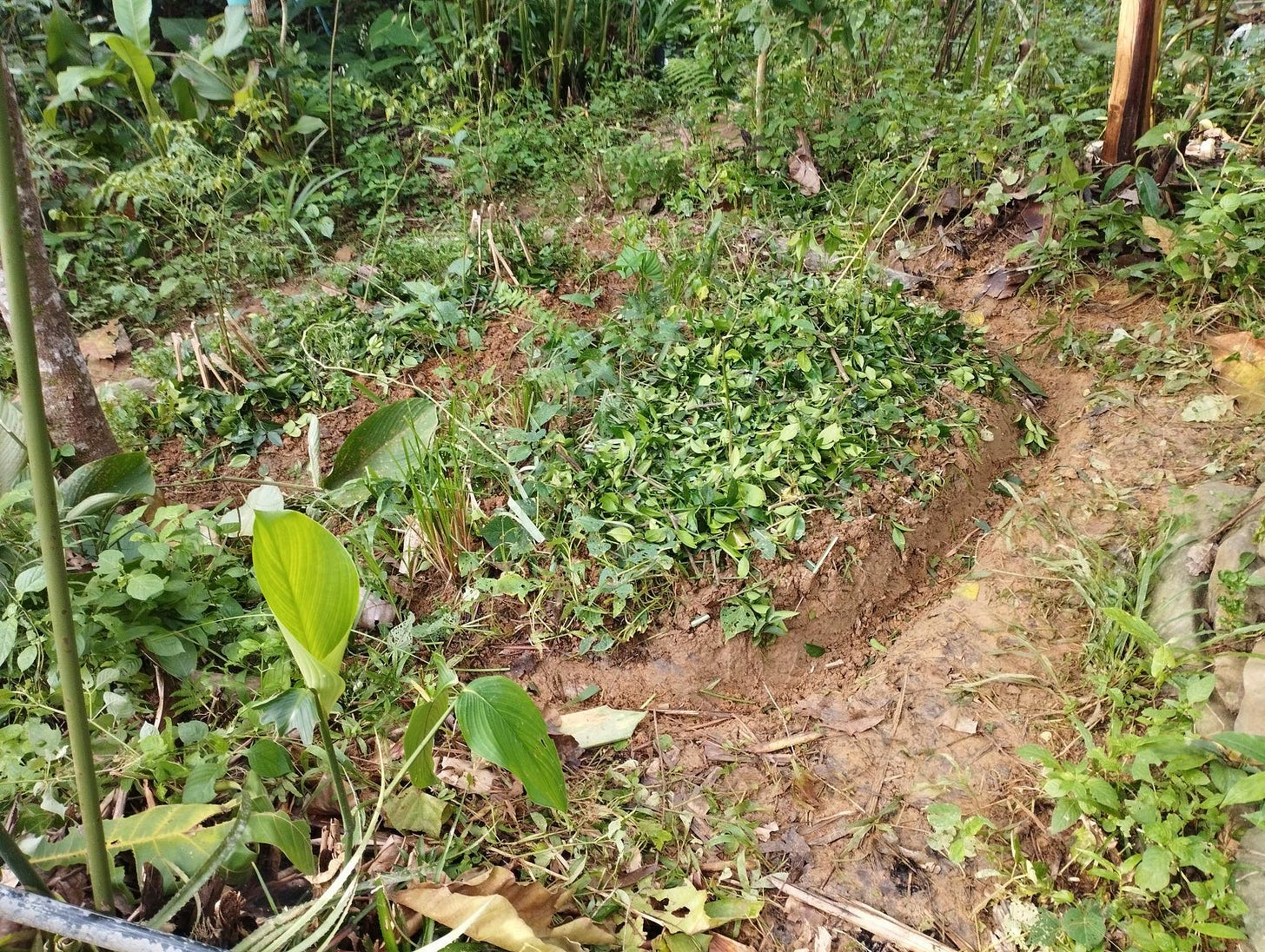
Speak of the devil: the chickens have thankfully become less interested in our vegetable beds. The soil has been compacted considerably by the rain, so digging up worms is a lot more work. At the same time, there are more termite highways through the mulch in the upper part, which further diverts their attention.
But, admittedly, the sudden loss of interest is at least in large part due to the new fence we’ve managed to put up in between rain showers.
The old “chicken fence,” an upcycled fishing net, had fallen into utter disrepair and spotted holes of various sizes every few meters that the chickens used to come and go as they pleased. It had become merely a loose symbolic boundary which the chickens paid less and less attention to. We were sure that we wouldn’t able to replace it timely enough (and, until a recent donation, we lacked the funds for higher quality netting – many thanks to
!), so we thought we’d just improvise for another few months.13Yet, in the end, the chicken became so cunning and stealthy that it was a constant effort to keep them at bay and prevent them from ravaging our freshly-seeded vegetable beds. On some occasions, after they repeatedly sent down small units to divert our attention while the larger group wreaked havoc in the part that we didn’t patrol (yes, chickens can be excellent strategists!) we became seriously angry with them, and putting up the new fence shows unequivocally that a line has been crossed, one too many times.
Two weeks after replacing the fence, it seems they’ve largely gotten the message.
The funny thing is, all of the chickens can still break out relatively easily, since the fence is a mere two to three meters high. They can simply climb the trees inside the chicken pen and fly over the fence, and they do so as soon as they get too bored and/or hungry. At best, the new fence buys us an additional one or two hours until they venture closer to the house (and hence the vegetable growing areas) again, which is nonetheless buffer enough, usually. Once they come too close to the house, we feed them their daily rice tribute inside the chicken pen, close the door, and have our peace for half a day.
In rainy season, we have to keep the chicken pen mulched at all times, since erosion would otherwise be catastrophic. The soil has eroded considerably already, which seemingly can’t be avoided completely if you don’t move them around often enough (for which we have neither the time, nor the land).
An old Chinese proverb states that “the best fertilizer are the gardener’s footsteps” – and while there’s undoubtedly plenty of truth to it, during the tropical monsoon it is sometimes best to limit ones footsteps.
Apart from the chicken pen, the most severe erosion on our land happens on the steepest parts of our most frequently used footpaths. As a (temporary) remedy, we build stairs from bamboo, which we fill up with stones. The space in between the stones will be filled in by the runoff after the next heavy shower, and afterwards the stairs are complete, and will hold between one and three years (depending on the quality and thickness of the bamboo used). We will slowly replace them with more permanent construction made from larger stones, but suitable stones are not easy to find and have to be carried uphill, so it will take a few more years of “sustainable development” until we are satisfied with the state of our footpaths.
Erosion control? How about reversing erosion!
As I’ve detailed in a recent post, one of the main ways we fertilize trees and reverse erosion is to excavate mud from our pond, a common seasonal task during dry season. In rainy season, a recurring task – and the primary way to reverse erosion – is to dig out the many levels of swales that run along the contour of our land.
Swales have gotten a lot of bad rap in recent years, partly because they seem to be part & parcel of an oversimplified “Permaculture formula” that is applied indiscriminately to a wide range of circumstances, whether necessary or not. But on our hillside land swales are indispensable. They not only slow down the rainwater runoff (which rushes down the slope with considerable force), but catch part of the sediment, which accumulates as fine silt. Several times each rainy season – usually when it hasn’t rained for a few days in a row – we dig out this rich mud, fill it into buckets, and carry it uphill to dump it around the base of banana plants or fruit trees.
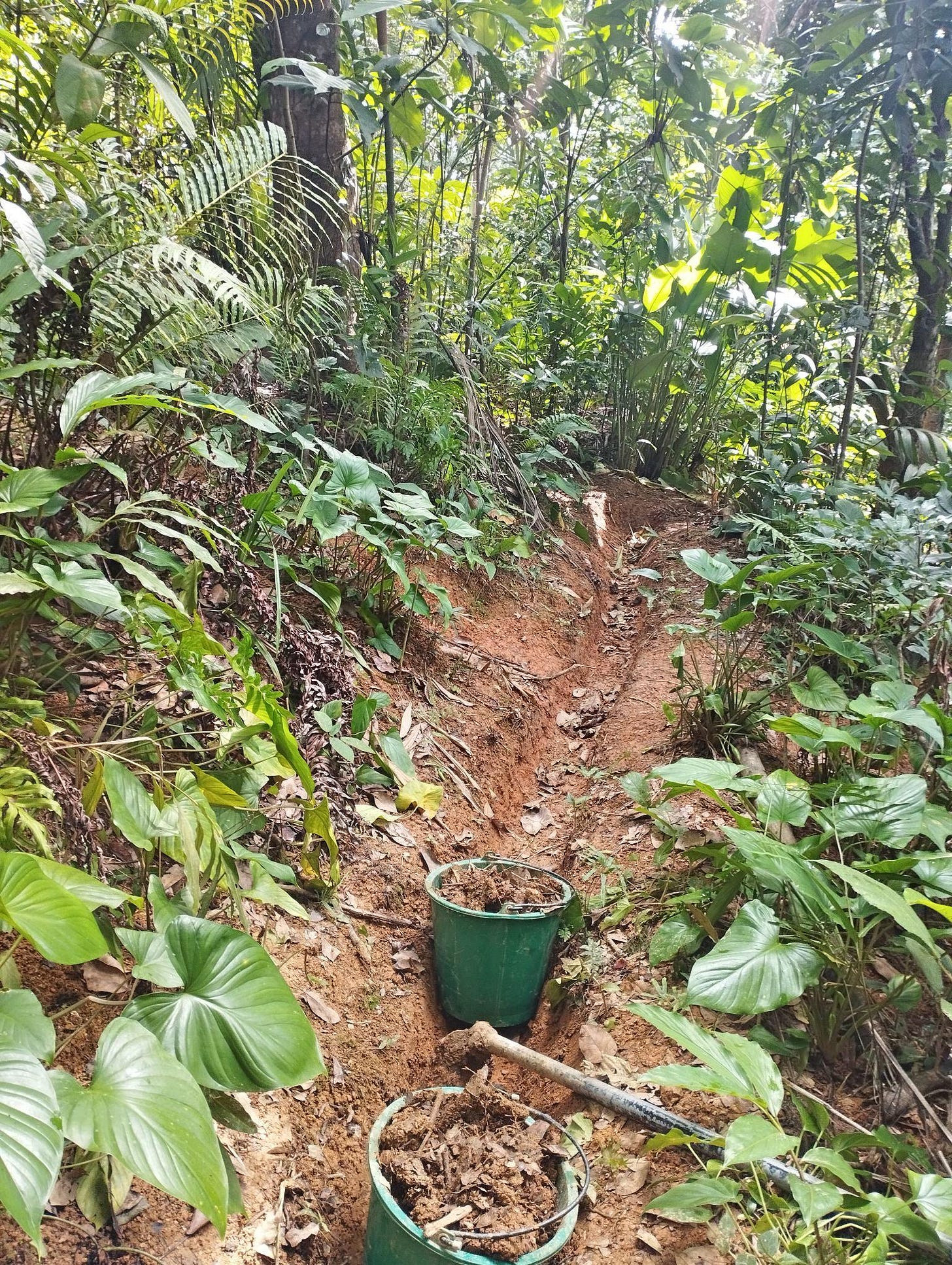
While we usually prefer Fukuoka’s wu wei approach (sometimes misleadingly translated as “do-nothing farming”), these tasks are both our most direct violation of the Tao – mountains erode and soil wants to move downhill – and the most essential way to ensure continued fertility and keep the land from degrading.
It is hard work, yes, but it’s also immensely rewarding – which could just as well be said of the subsistence lifestyle in general.
Because no matter how difficult life gets for us, living with the land is still vastly preferrable over any of the present alternatives. My biggest wish is that we will somehow manage to continue to do so, in spite of intensifying climatic & financial stressors, because we have absolutely no clue as to what we would do otherwise.
We’ve come way too far to give up now – so onwards & upwards it is!
This is as good a place as any to wrap up the current Rambling, before I get carried away completely.
There is a lot more to tell, and a few more important issues that merit closer examination (but had to be cut from the current draft in order to maintain some slight semblance of brevity), which I will address in consequent Rewilding Updates, coming soon.
Instead of Part this, Part that, from now on I will simply post news from our project (accompanied with thoughts & reflections) intermittently in the category “Rewilding Updates.”
Stay tuned for the next Rewilding Update – including topics like Water Scarcity, Water Overabundance and the End of Bananas – out soon!
I write stuff like the above in my free time, when I’m not tending the piece of land we’re rewilding here at Feun Foo. As a subsistence farmer by profession I don’t have a regular income, so if you have a few bucks to spare please consider supporting my work with a small donation:
If you want to support our project on a regular basis, you can become a Patron for as little as $1 per month - cheaper than a paid subscription!
A 2010 report for the US National Intelligence Council titled Southeast Asia: The Impact of Climate Change to 2030 – Geopolitical Implications. Great read, and pretty much spot on so far.
Many of the landslides that happened in Vietnam, Laos, Thailand and Myanmar as a result of typhoon Yagi were in large part a result of the rampant deforestation and plowing up of hillsides.
The narrow strip along the coast on which we are located is right on the edge of the evergreen tropics (Köppen climate classification: Am, tropical monsoon climate), where hypertropicals like durian and cempedak can still be cultivated – albeit with occasional bad years. Thirty kilometers north is tropical savannah (Aw).
If you swallow only a part of this lump, you’ll easily start gagging because it’s still connected by silky threads to the rest of what remains in your mouth. The easiest way to eat “wet jackfruit” is to bite off small chunks and pull the threads until they tear (like strands of molten cheese).
Still experimenting with “Nature’s pronouns” – I’m not yet sure if I like it.
There would be a pretty obvious way to deal with the issue, but any discussion thereof would make me liable to prosecution under current law. One time last month, a monkey came up to our house and ate a whole hand of bananas, carefully placing the folded-up skins on the ground for us to puzzle over when we returned from the market. It took us a while to figure it out, because no monkey ever ventured so close to our house, so we didn’t quite believe it at first. I saw him a week later, when we were reading quietly in our hammocks. He was in the cempedak tree right behind the house, and didn’t seem in a big hurry to get away once I alerted him to my presence (“Ahem!”). He casually walked over to a jackfruit tree a few meters away, swung into the lowest branch fork, turned around and looked at me with his chin high up and an expression that said “what’cha gonna do.”
Let’s see in which direction this relationship will develop.
This is still relatively low when compared to commercial durian farming, where mature trees easily produce upwards of 100 fruits per year each.
The smell lingered in the air for three straight days, causing the population in the lower hive to promptly abandon it. We’ve never smelled this chemical before – it reminded me of the surfboard wax I used in my previous life. We suspect it might be a neonicotinoid, but it’s definitely not one of the usual organophosphates.
Incredibly enough, we still don’t have a single healthy moringa tree (Moringa oleifera), and the only Jamaican cherry tree (Muntingia caloneura) left died during the last period of intense rain. Usually those trees grow with spectacular ease and vigor, even in compacted and nutritionally poor soil such as on roadsides or in urban parking lots. On a similar note, most “regular” vegetables are still a complete waste of time for us when considering EROI: we grew a handful of tiny pumpkins this year, and a few bowls of cherry tomatoes. And we even harvested an odd eggplant here and there – progress!
lit.: “have-eat-not-have-sell, have-sell-not-have-eat” – you gotta love the Thai language!
Of course we have to remember that conventional agriculture is only “less labor-intensive” in regard to the immediate labor input. When considering the manufacturing of farming equipment & chemical inputs, and the mining and processing of materials needed for them, the vast transport network and its maintenance, and the total amount of work it takes to remedy the damage caused to health & environment (plus the amount of restoration work that would be required to mitigate the downstream effects of all the aforementioned), conventional/industrial agriculture looks like it is a lot more labor-intensive than alternative practices.
Max Wilbert has recently argued convincingly that alternative cultures aren’t enough – what we really need are oppositional cultures. If we don’t start fighting back soon the system will stomp us out (or re-incorporate us) one by one, until there’s nothing else left, no other way but the one provided by the dominant culture.
Our current tactic is to hurl plastic bottles filled with a little water into their direction, accompanied with an angry (and hopefully intimidating) “Sssssshhhh, ssssssshhhhh!!”



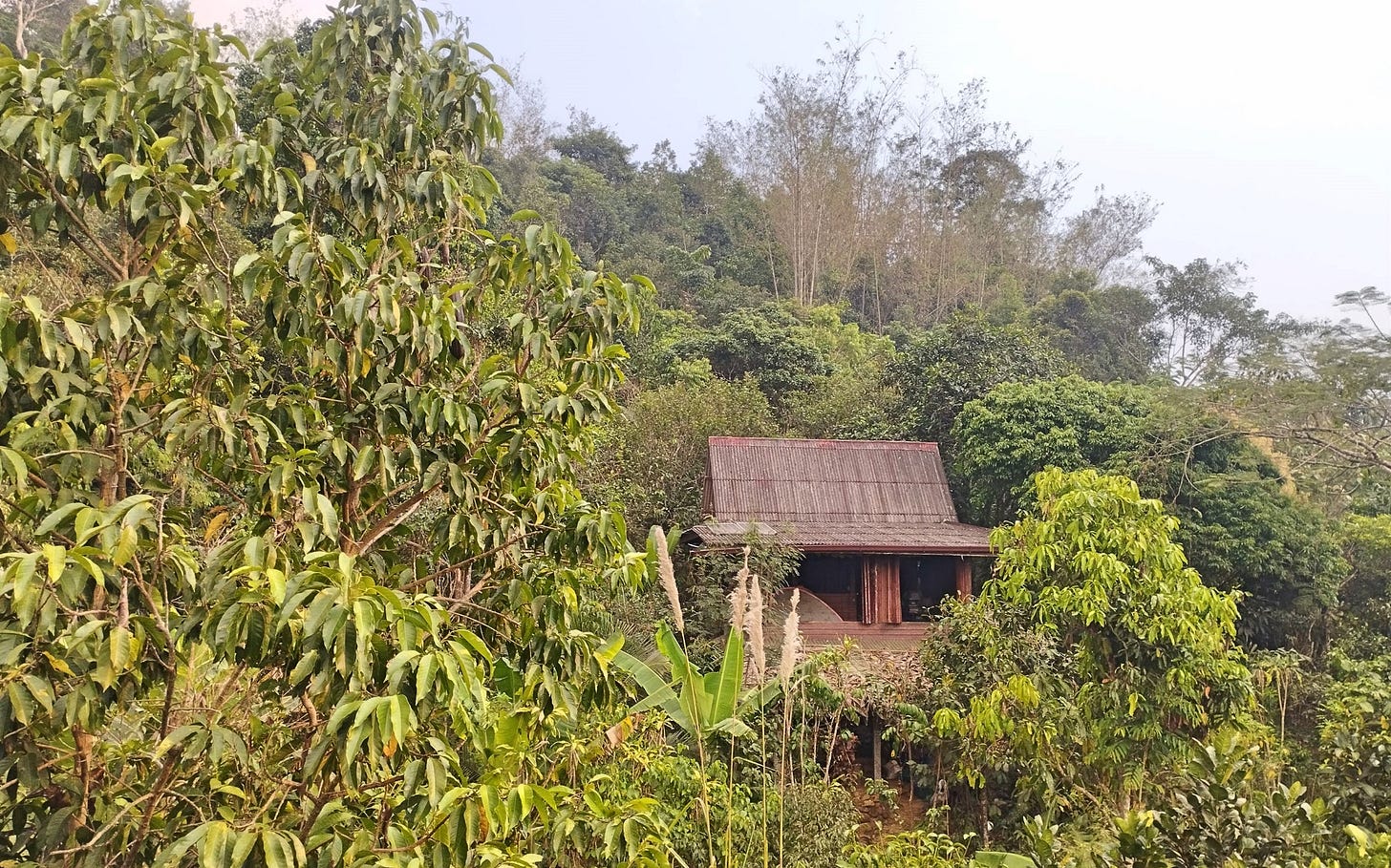

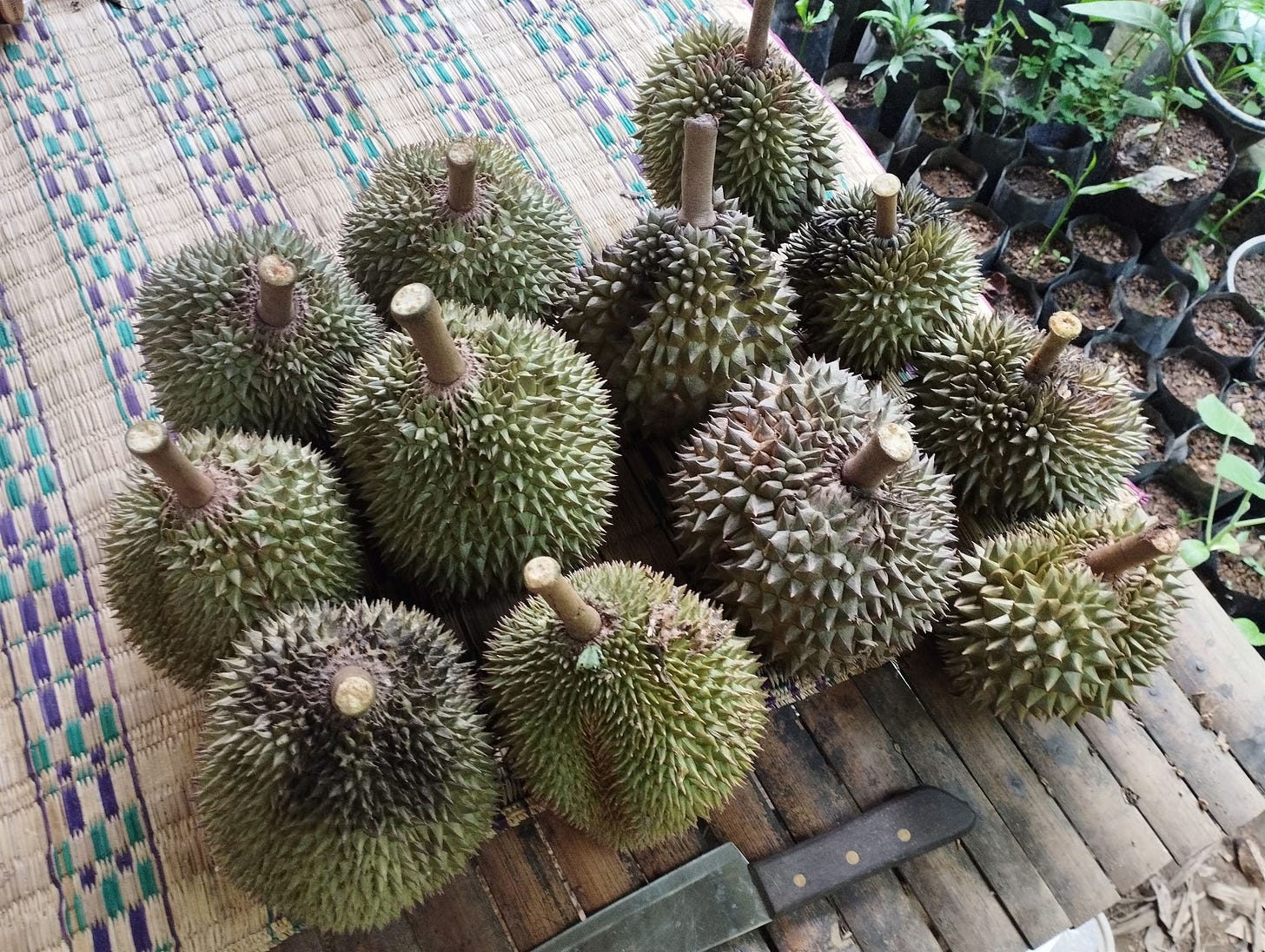
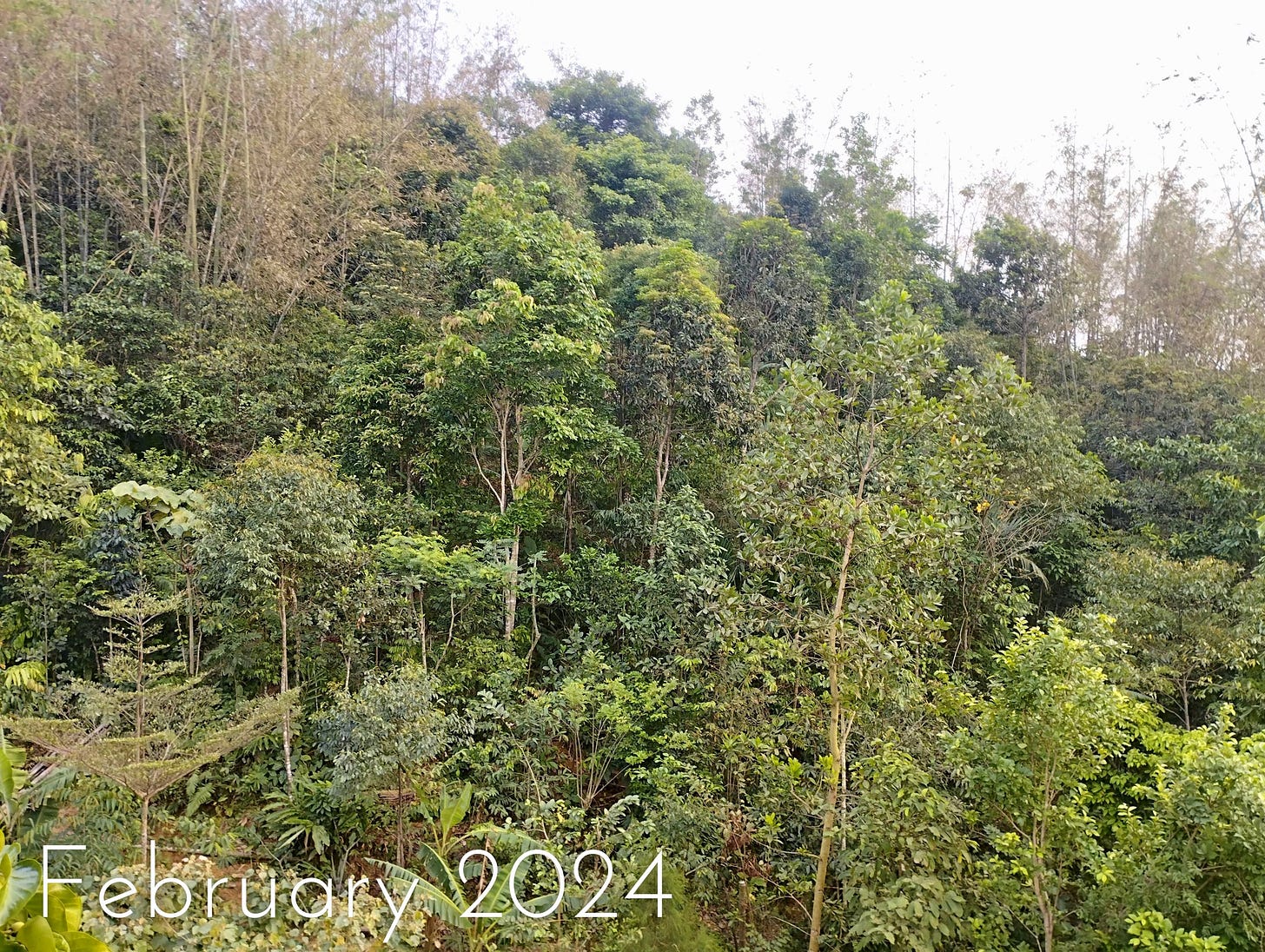
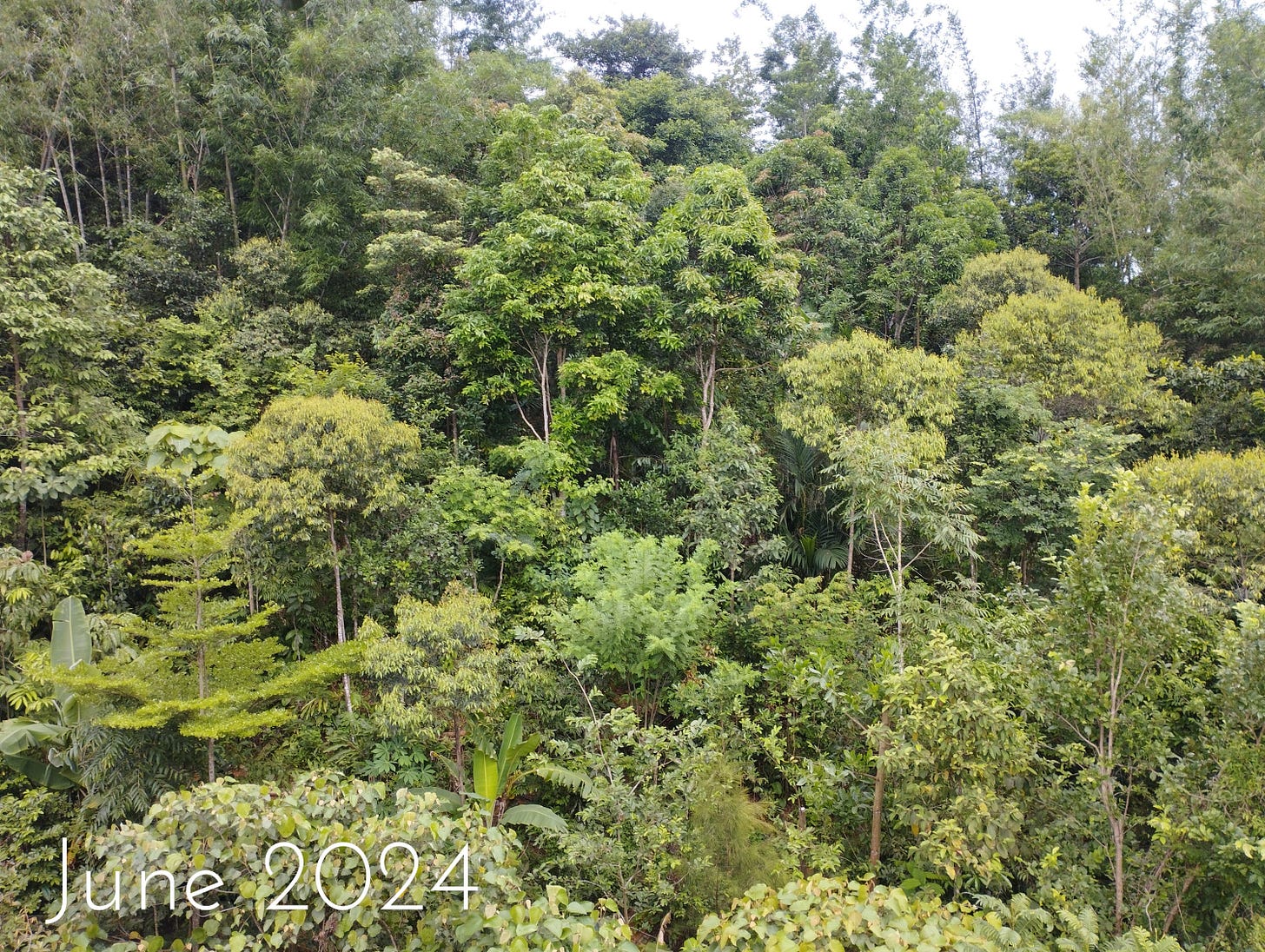
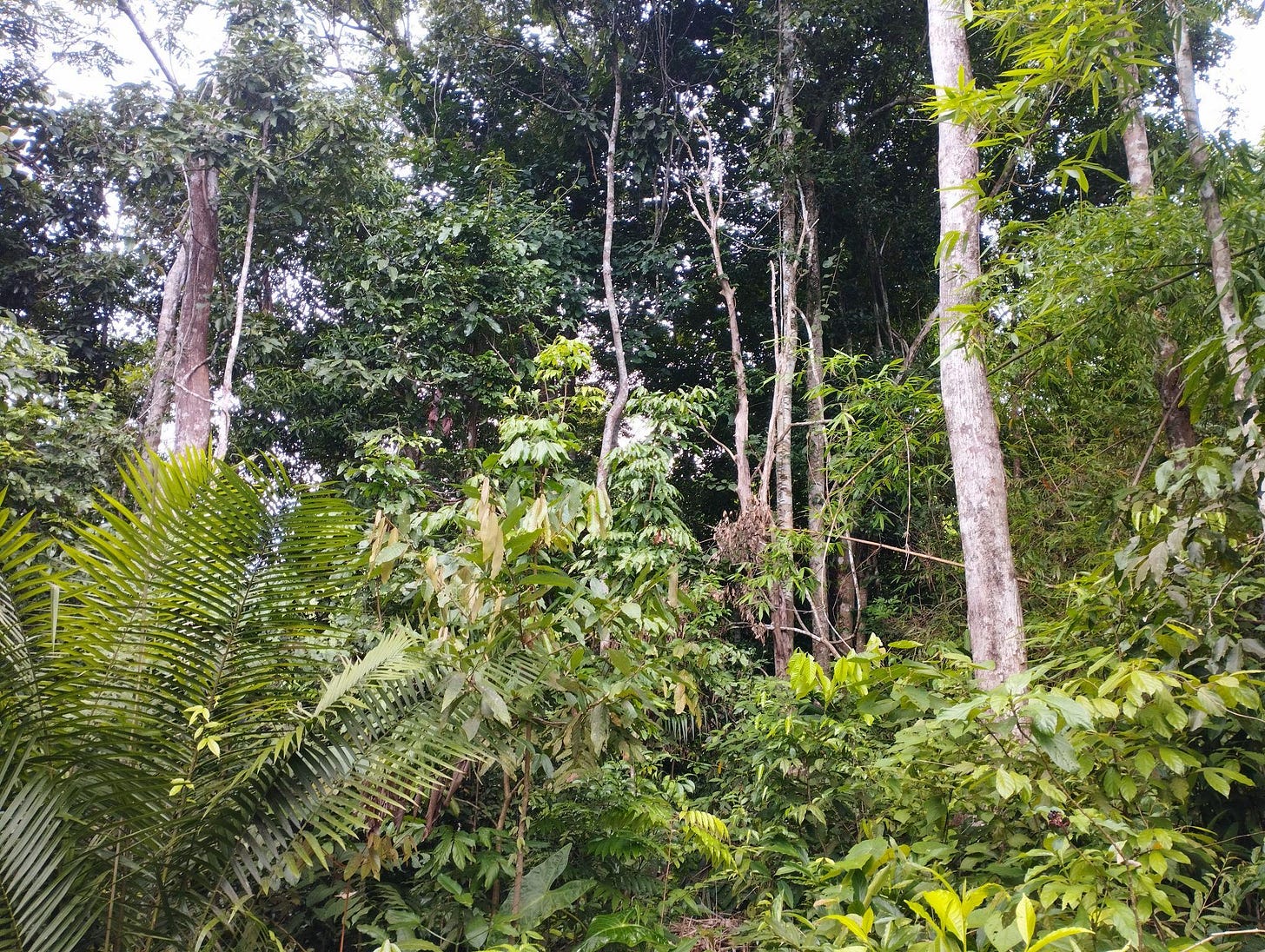

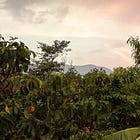
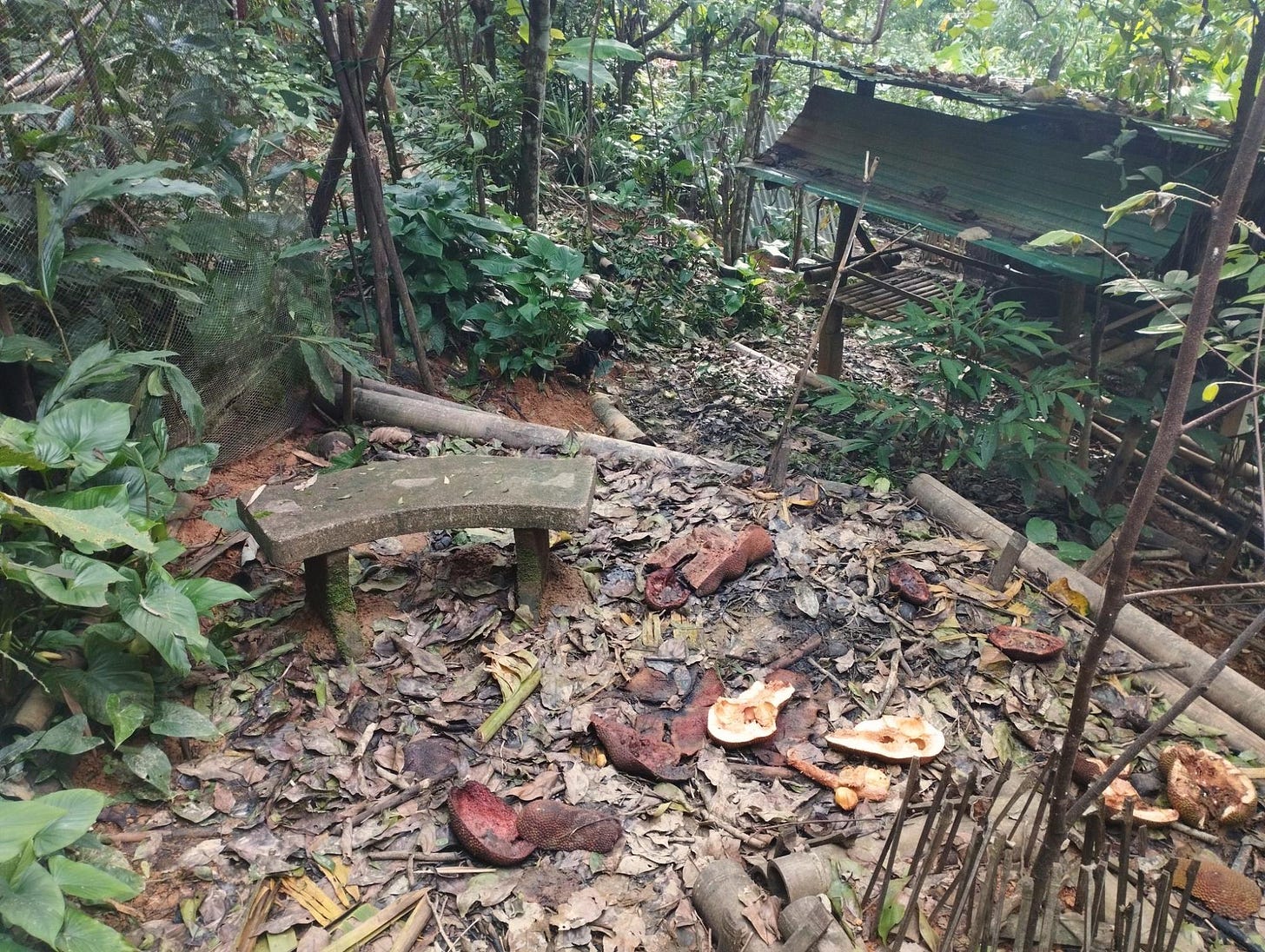
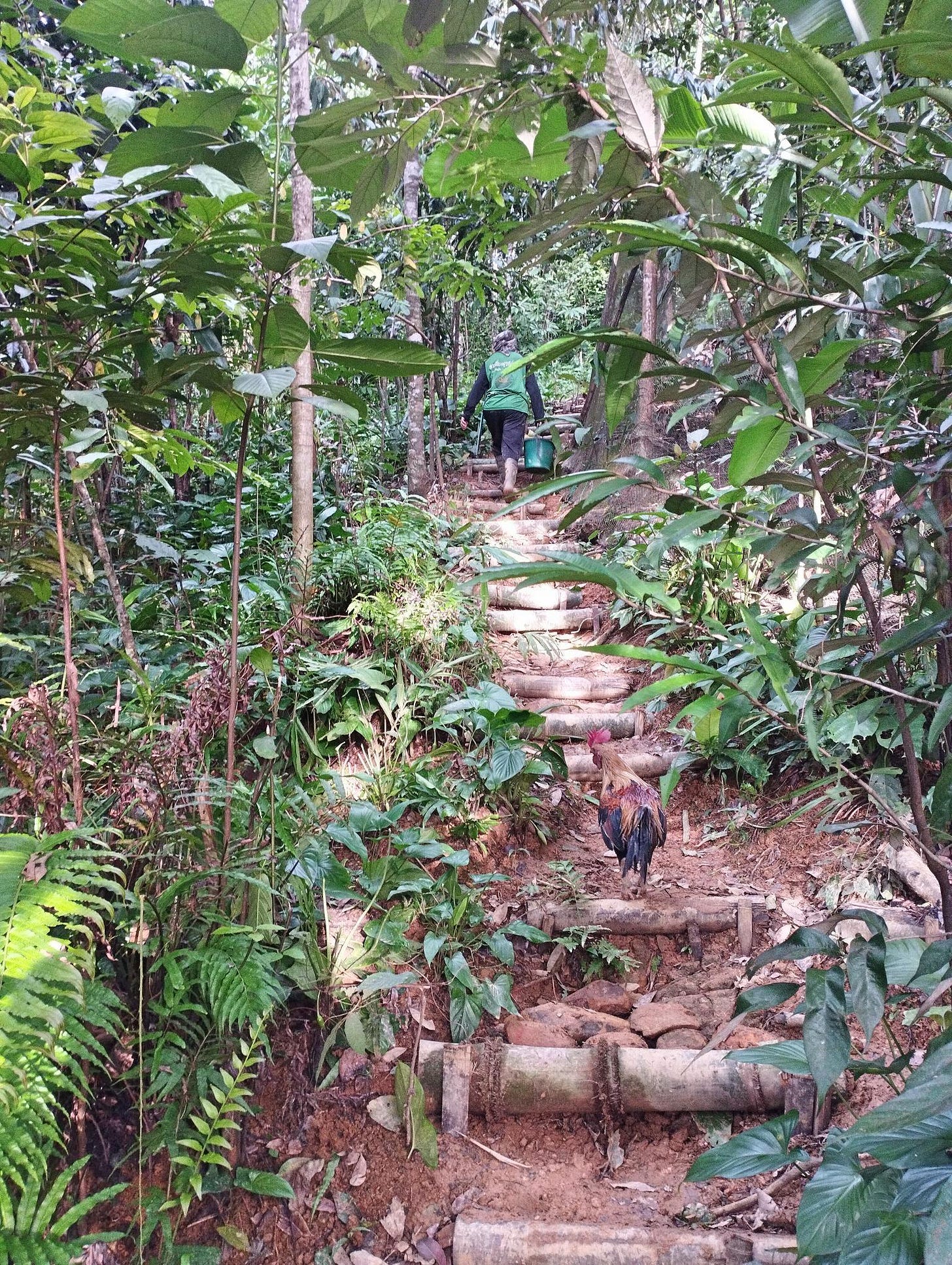

Its nice seeing you guys develop such sensitivity and knowledge of your specific land. The handcrafted and frequently maintained swales say something. I am one of those a bit disillusioned by swales after seeing it implemented by machines that push forests over to create swales. I think the maintenance of swales isnt something often talked about too. If the berm is no longer level then you can be creating a concentration of water that erodes into a gully. Farming on hillside isnt forgiving so kudos to you guys!
What kind of net for the chickens do you use? Snakes often get trapped in nets so hopefully the hole size is right and you harvest a few.
We do our daily tribute to the chickens and ducks as well when they start coming into our open kitchen and pooping all over. But I also feel the tribute reinforces their behaviour to come and harass us.
Yes I was wondering the obvious about the monkeys. We recently caught two in traps meant for wild boar. My wife havent cooked them because she is unsure how to cook it. There seems to be more big animals (boars, pythons, monitor lizards, monkeys) where I am maybe because my neighbours do not eat them because they are Muslims. But they do poison or kill them if they interfere with their farming. We have been fortunate with wild meat (python, monkey, boar) the past few months and the freezer is full! I am thinking of learning to use bow and arrow too.
Wow, havent heard of jackfruit and cempedak seeds being used as a staple. Do you find cempedak easier to care for than jackfruits since the latter often require wrapping? My trees are still young so i have no idea but over here jackfruits are often eaten green maybe because monkeys and squirrels get them first. Havent heard of wet jackfruit but I now spit out the fiber of the cempedak since it chokes me too.
Loved reading this update. It is so fascinating to hear the ins ad outs of other systems in other places. Looks like Artocarpus might be the best suited staple genus for your situation. Are you planning on gathering wider diversity and maybe doing some more hybridisation? How are the more uncommon species you mentioned trying holding up during the drought? Getting the first wide crosses done is a huge challenge compared to the explosion of diversity and vigor than happens on the other side, so I hope you keep steadily pushing in that direction. Especially for tree crops it often takes years to get all the ingredients lined up at the right time, waiting for just the right season to open the door to new possibilities.